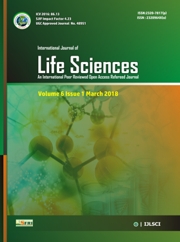Research Article
Volume 8 |Issue 6| November-December 2020 First published: 12 December 2020
Metabolite effect of Alternaria alternata (Fr.) Keisler on seedling emergence of Hordeum vulgare L.
Bhajbhuje MN
Department of Botany, Jawaharlal Nehru Mahavidyalaya, Wadi, Nagpur-440 023 (M.S.) India.
Email : dr_mnbhajbhuje@rediffmail.com
Abstract
Keywords:Fungal metabolite, Hordeum vulgare L, Alternaria alternata, green biomass, vigour.
Editor: Dr.Arvind Chavhan
Cite this article as:
Bhajbhuje MN. Metabolite effect of Alternaria alternata (Fr.) Keisler on seedling emergence of Hordeum vulgare L., Int. Res. Journal of Science & Engineering, 2020, Volume 8(6): 219-226.
Copyright:
Open Access This article is licensed under a Creative Commons Attribution 4.0 International License, which permits use, sharing, adaptation, distribution and reproduction in any medium or format, as long as you give appropriate credit to the original author(s) and the source, provide a link to the Creative Commons license, and indicate if changes were made. The images or other third party material in this article are included in the article’s Creative Commons license, unless indicated otherwise in a credit line to the material. If material is not included in the article’s Creative Commons license and your intended use is not permitted by statutory regulation or exceeds the permitted use, you will need to obtain permission directly from the copyright holder. To view a copy of this license, visit http://creativecommons.org/ licenses/by/4.0/
References
1. Holensein JE, Stoessi A. Metabolites of Alternaria solani Part IX : Phytotoxocity of Altersolarol-A Envi. Health Penlt., 2008; 108(2): 143-147.
2. Bhajbhuje MN. Evaluation of Karyotoxicity of Fungal Metabolites on somatic cells of three varieties of Lycopersicon esculentum Mill. Indian Streams Research Journal, 2013; Pp 24-27.
3. Wikipedia. Hordeum vulgare L. Wikimedia Foundation, Org. en.wikipedia,org/wiki. Inc . 2020. (Retrieved on September, 22, 2020).
4. Zare YL. Karaj, Iran, The causal agent of barley black point disease in certified seed lots in Iran., International Journal of Agriculture and Crop Scis., 2013, 5(4):332-335.
5. Sung GH, Bhushan S, ParkK. B. Park, S.K. Han and J.M. Enhancing effect of Shimizuomyces paradoxus on seed germination and seedling growth of Canola, Plant growth of Cucumber and Harvest of tomato. Mycobiology, 2011; 39 (1) : 7-11.
6. Bhajbhuje, MN. Response of metabolites of Alternaria solani on seed germination, seedling vigour vigour of Solanum nigrum L Int. Jour. Life Sci. 2016 4(4): 615-618.
7. Tsuge T, Harimoto Y, Akimitsu K, Ohtani K, Kodama M, Akaqi Y, Equsa M, Yamamoto M, and Otani, H (2013) Host-selective toxins produced by plant pathogenic fungus Alternaria alternata, Fed. of European Microbiol. Soc. (FEMS) Microbiol. Rev, 2013; 37(1) : 44-66.
8. ISTA. Seed Testing. International ISTA News Bulletin No. 143. Zurich, Switzerland, 2020.
9. Brakhage AA, Schroeckh V. Fungal secondary metabolites in strategies of activate silent genegene of clusters. Fungal Gene. Biol.,2011; 48(1) : 15-22.
10. Bhajbhuje, MN, Punam Pathode. Role of metabolites on viability and seedling emergenceof Triticum aestivum L. Int. Jour. Life Sci., Special Issue A2 Oct.2014: 6-10
11. Nowicki M., Nowaskwska M, Niezgoda. A. Kozik EU. Alternaria black spot of crucifer : Symptoms, importance of disease and perspectives of resistance breeding. Vegetable Crop research Bulletin, 2012; 76, 5-19
12. Chung Kung-Ren. Stress response and pathogenicity of the Necrotrophic fungal pathogen Alternaria alternata. Scientific, 2012; 20(12) : 635-641.
13. Bhajbhuje MN, Bisan VV, Jagtap DG. Role of toxic metabolites of Alternaria brassicae (Bert.) on somatic cells of Brassica spp. J. Soils and Crops, 1992; 2(2) : 59-61.
14. Bhajbhuje, MN. Response of metabolites from culture filtrate of Alternaria species against Triticum aestivum L. International Jour. of Life Science, 2015 3(1) : 55-62
15. Rahman, RS., Banglasdes., Effect of culture filtrates of Trichoderma on seed germination and seedling growth in chili., International Journal of Biosciences., 2012, 2(4),pp: 46-55.
16. Raithak , PV, Gachande , BD., Effect of culture filtrates of tomato plant pathogenic fungi on seed germination and seedling growth of tomato (Lycopersicon esculentum Mill.). Curr. Bot., 2013, 4(1):9-11.
17. Wagh P, Sinha S, Singh HK, Khare UK. Pathogenic behavior of Alternaria alternata and phytotoxicity of its culture filtrates on Lepidium sativum:A medicinal herb of immense pharmacological potential. The Bioscan, 2013, 8(2): 643-647.
18. Helambe SS, Dande RP. Fenugreek (Trigonella foenum-graceum L.) An Overview International Journal of Current Pharmaceutical Review and Research, 2012; 2(4) : 169-187.
19. Thavaranjit, AC, Jaffin, Sri Lanka., Soil born fungi promote seed germination In-vitro on Vigna spp., J. of global Bioscience., 2016, 5(3):pp:3742-3746.
20. EFSA. Scientific Opinion on the risks for animal and public health related to the presence of Alternaria toxins in feed and food EFSA Journal, 2011; 9(10):2407.

